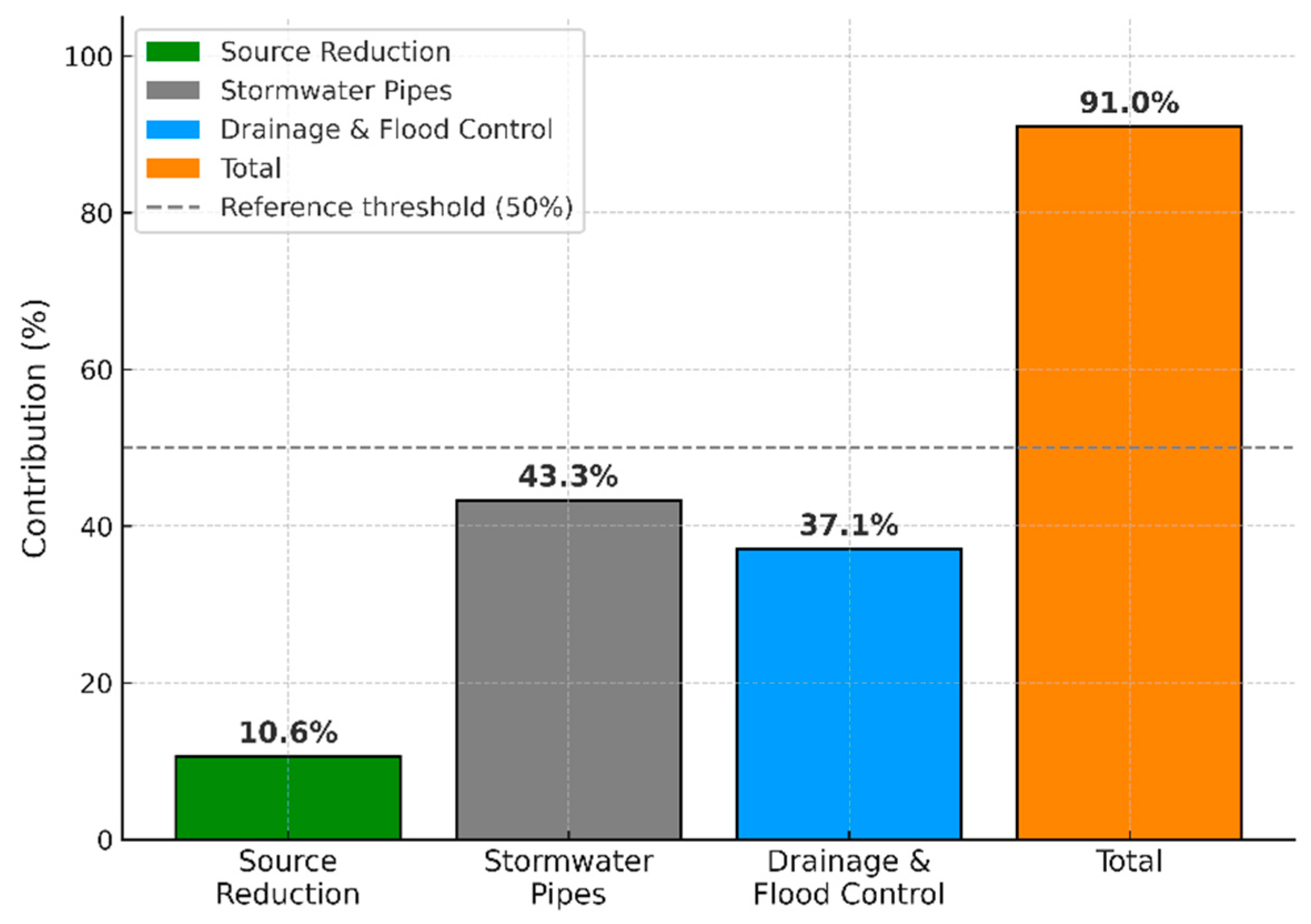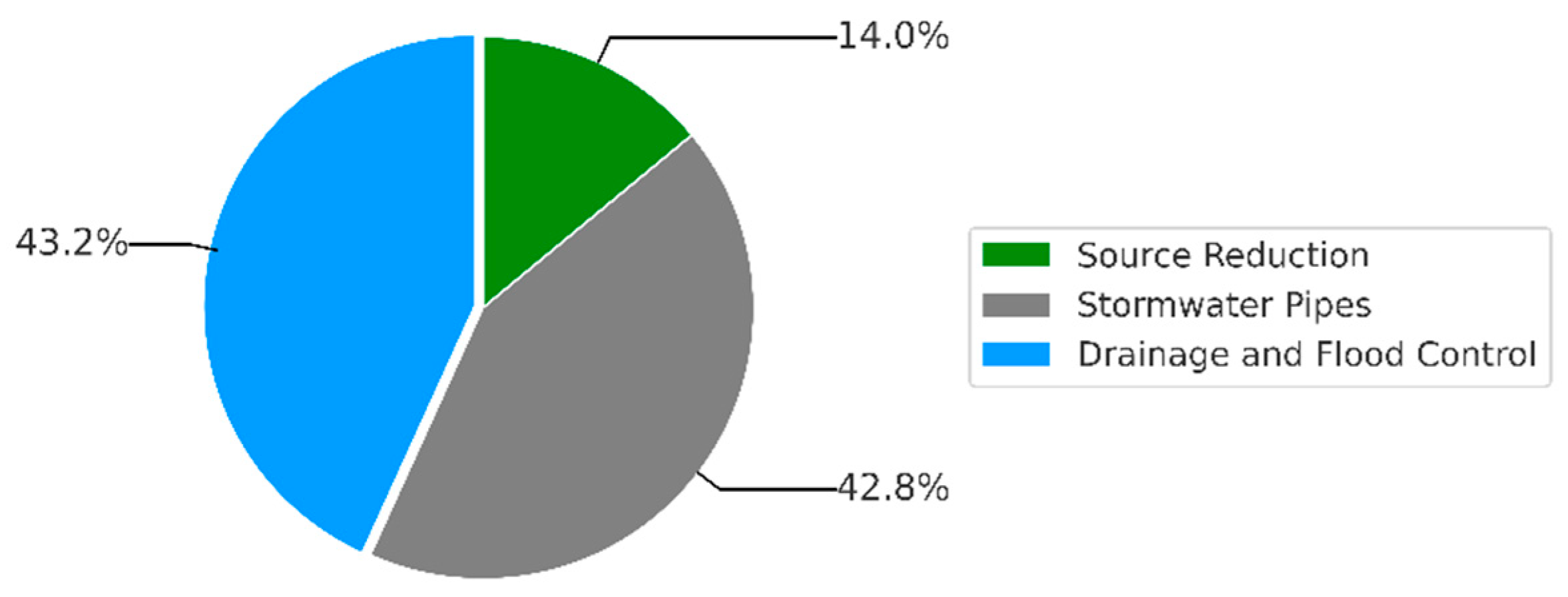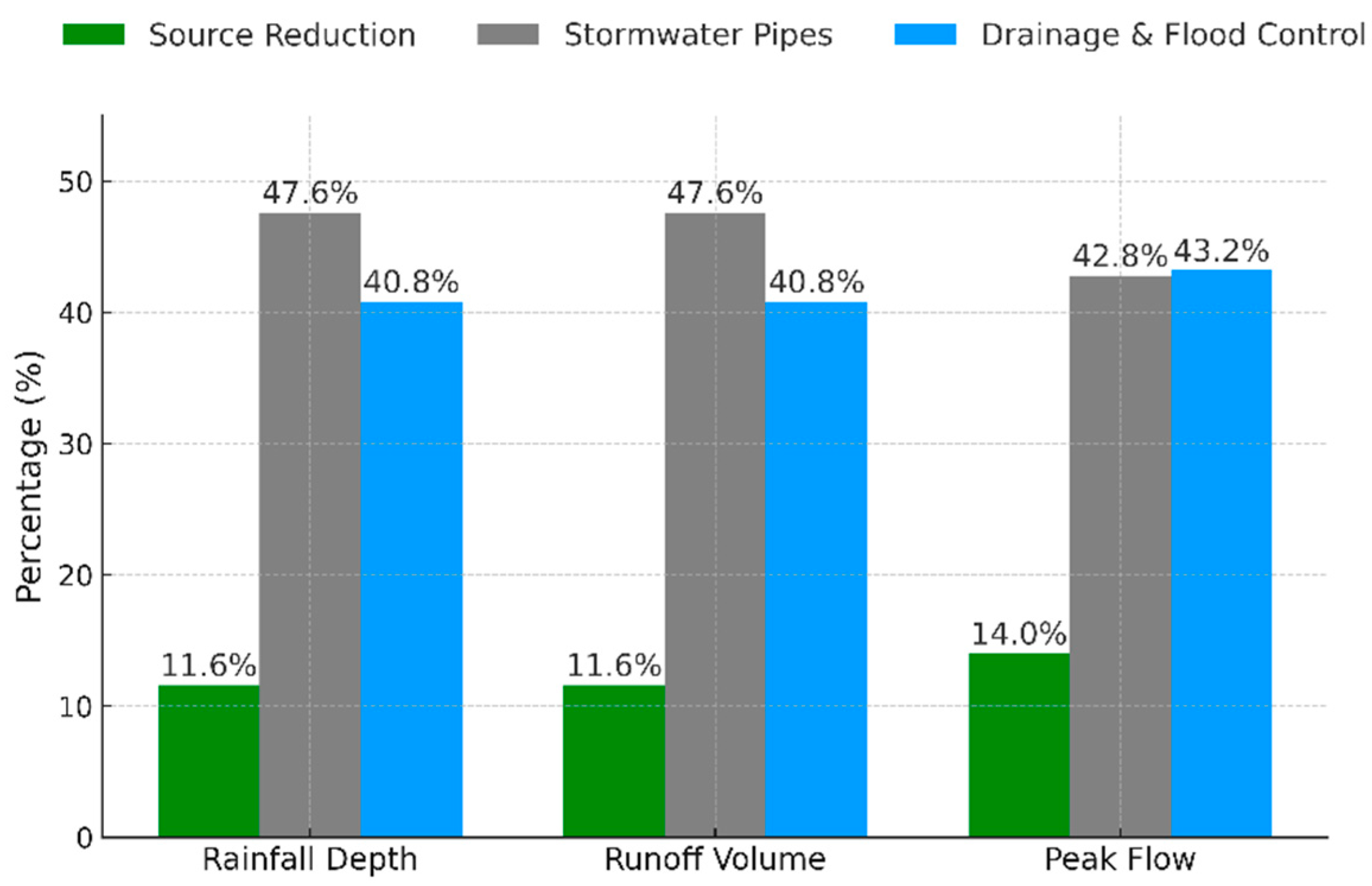A Multi-Dimensional Contribution-Based Framework for Evaluating Urban Stormwater Management Efficiency
Abstract
:1. Introduction
2. Methodology
2.1. Conceptual Framework
2.1.1. Core Design Principles for Multi-Dimensional Evaluation
2.1.2. Theoretical Basis and Key Equations of the Framework
2.1.3. Multi-Dimensional Evaluation Metrics
2.1.4. Comparison with Conventional Hydrological Models
2.1.5. Stepwise Implementation of the Multi-Dimensional Urban Stormwater Assessment Framework
2.1.6. Innovation and Practical Applications
2.2. Methodology Description
2.2.1. Computation of Rainfall Depth Contribution
2.2.2. Computation of Runoff Volume Contribution
2.2.3. Computation of Peak Flow Contribution
2.3. Case Study: City A
2.3.1. Overview of City A
2.3.2. Subsystem Parameter Configuration
- (1)
- Source Reduction System
- (2)
- Stormwater Pipe System
- (3)
- Drainage and Flood Control System
2.3.3. Data Sources and Assumptions
2.3.4. Case Study Implementation Steps
2.3.5. Significance of the Case Study
3. Results
3.1. Rainfall Depth Contribution Analysis
3.2. Runoff Volume Contribution Analysis
3.3. Peak Flow Contribution Analysis
4. Discussion
4.1. Key Innovations and Contributions
4.2. Analysis of Subsystem Performance and Synergistic Effects
4.3. Multi-Scenario Performance Comparison and System Vulnerability Assessment
4.4. Analysis of Relative Subsystem Contribution
4.5. Comparative Analysis with Traditional Hydrological Models
4.6. Theoretical Significance
4.7. Practical Implications
4.8. Future Research Directions
5. Conclusions
Author Contributions
Funding
Data Availability Statement
Conflicts of Interest
References
- UN-Habitat. World Cities Report 2020: The Value of Sustainable Urbanization; United Nations Human Settlements Programme: Nairobi, Kenya, 2020; Available online: https://unhabitat.org/world-cities-report-2020-the-value-of-sustainable-urbanization (accessed on 16 April 2025).
- IPCC. Climate Change 2021: The Physical Science Basis. Contribution of Working Group I to the Sixth Assessment Report of the Intergovernmental Panel on Climate Change; Cambridge University Press: Cambridge, UK, 2021. [Google Scholar] [CrossRef]
- Mahadeva, M.; Abhijth, C.C.; Harshith, V.E.; Leela, N.R.; Naik, N.S. A review on urban flooding in Bangalore: A growing environmental crisis. J. Environ. Eng. Stud. 2025, 10, 11–19. [Google Scholar] [CrossRef]
- Mao, Y.; Li, Y.; Bai, X.; Yang, X.; Han, Y.; Fu, X. Scenario-based green infrastructure installations for building urban stormwater resilience—A case study of Fengxi New City, China. Sustainability 2024, 16, 3990. [Google Scholar] [CrossRef]
- GB 50014:2021; Standard for Design of Outdoor Wastewater Engineering. Ministry of Housing and Urban-Rural Development of the People’s Republic of China. China Planning Press: Beijing, China, 2021.
- Rossman, L.A. Storm Water Management Model User’s Manual; version 5.1; U.S. Environmental Protection Agency: Cincinnati, OH, USA, 2015. Available online: https://www.epa.gov/water-research/storm-water-management-model-swmm (accessed on 16 April 2025).
- Fletcher, T.D.; Andrieu, H.; Hamel, P. Understanding, management and modelling of urban hydrology and its consequences for receiving waters: A state of the art. Adv. Water Resour. 2013, 51, 261–279. [Google Scholar] [CrossRef]
- Arnbjerg-Nielsen, K.; Willems, P.; Olsson, J.; Beecham, S.; Pathirana, A.; Bülow Gregersen, I.; Madsen, H.; Nguyen, V.T.-V. Impacts of climate change on rainfall extremes and urban drainage systems: A review. Water Sci. Technol. 2013, 68, 16–28. [Google Scholar] [CrossRef] [PubMed]
- Dotto, C.B.; Mannina, G.; Kleidorfer, M.; Vezzaro, L.; Henrichs, M.; McCarthy, D.T.; Freni, G.; Ashley, R.; Bertrand-Krajewski, J.-L. Comparison of different uncertainty techniques in urban stormwater quantity and quality modelling. Water Res. 2012, 46, 2545–2558. [Google Scholar] [CrossRef] [PubMed]
- Elliott, A.H.; Trowsdale, S.A. A review of models for low impact urban stormwater drainage. Environ. Model. Softw. 2007, 22, 394–405. [Google Scholar] [CrossRef]
- Ahiablame, L.M.; Engel, B.A.; Chaubey, I. Effectiveness of low impact development practices: Literature review and suggestions for future research. Water Air Soil Pollut. 2012, 223, 4253–4273. [Google Scholar] [CrossRef]
- Palla, A.; Gnecco, I. Hydrologic modeling of low impact development systems at the urban catchment scale. J. Hydrol. 2015, 528, 361–368. [Google Scholar] [CrossRef]
- Che, W.; Zhang, W. Urban water management for future cities. In Urban Water Management for Future Cities; Köster, S., Reese, M., Zuo, J., Eds.; Springer: Cham, Switzerland, 2019; pp. 3–11. [Google Scholar]
- Jia, H.; Yao, H.; Shaw, L. Advances in LID BMPs research and practice for urban runoff control in China. Front. Environ. Sci. Eng. 2013, 7, 709–720. [Google Scholar] [CrossRef]
- Freni, G.; Mannina, G.; Viviani, G. Uncertainty in urban stormwater quality modelling: The influence of model structure and calibration data. Sci. Total Environ. 2009, 408, 138–145. [Google Scholar] [CrossRef] [PubMed]
- Butler, D.; Davies, J.W. Urban Drainage, 3rd ed.; CRC Press: Boca Raton, FL, USA, 2011. [Google Scholar] [CrossRef]
- Raimondi, A.; Di Chiano, M.G.; Marchioni, M.L.; Sanfilippo, U.; Becciu, G. Probabilistic modeling of sustainable urban drainage systems. Urban Ecosyst. 2022, 26, 493–502. [Google Scholar] [CrossRef]
- Bach, P.M.; Rauch, W.; Mikkelsen, P.S.; McCarthy, D.T.; Deletic, A. A critical review of integrated urban water modelling—Urban drainage and beyond. Environ. Model. Softw. 2014, 54, 88–107. [Google Scholar] [CrossRef]
- Monachese, A.P.; Gómez-Villarino, M.T.; López-Santiago, J.; Sanz, E.; Almeida-Ñauñay, A.F.; Zubelzu, S. Challenges and innovations in urban drainage systems: Sustainable drainage systems focus. Water 2025, 17, 76. [Google Scholar] [CrossRef]
- Bosco, R.; Giacobbe, S.; Mozingo, L.A.; Valente, R. Urban green streets and water management safety hubs in public schools lots. IOP Conf. Ser. Earth Environ. Sci. 2024, 1402, 012011. [Google Scholar] [CrossRef]
- Chen, T.L.; Chen, L.; Shao, Z.; Chai, H. Enhanced resilience in urban stormwater management through model predictive control and optimal layout schemes under extreme rainfall events. J. Environ. Manag. 2024, 366, 121767. [Google Scholar] [CrossRef] [PubMed]







| Method | Data Requirements | Computational Complexity | Applicability |
|---|---|---|---|
| SWMM | Extensive—requires high-resolution topographic data, detailed drainage network layout, and high-frequency monitoring data | High—based on dynamic hydrodynamic simulations | Suitable for large urban catchments with robust data availability and sensor infrastructure |
| MIKE URBAN | Extensive—depends on real-time monitoring, sensor integration, and calibrated hydraulic models | Very High—employs advanced, multi-dimensional numerical simulations | Designed for metropolitan areas with complex and fully instrumented drainage systems |
| Proposed Method | Minimal—requires only rainfall intensity, catchment area, and basic system design capacity | Low—relies on direct analytical estimation methods | Highly applicable in diverse contexts, particularly effective in data-scarce or resource-limited regions |
| Subsystem | Parameter | Value | Unit |
|---|---|---|---|
| Source Reduction | Asponge | 50 | km2 |
| Hsponge | 30 | mm | |
| Agreen | 10 | km2 | |
| Hnon-sponge | 8 | mm | |
| Stormwater Pipes | Apipes | 90 | km2 |
| Hpipes | 60 | mm | |
| Qpumps | 1 × 105 | m3/h | |
| Drainage and Flood Control | Achannels | 0.5 | km2 |
| Qchannels | 4 × 104 | m3/h | |
| Vstorage | 4 × 106 | m3 |
| Rainfall Scenario | GH,total (%) | GV,total (%) | GQ,total (%) | Performance Deficit (%) |
|---|---|---|---|---|
| 30-year return period | 91 | 91 | 90.8 | 9.0–9.2 |
| 50-year return period | 81.9 | 81.9 | 75.7 | 18.1–24.3 |
| Category | Conventional Models (e.g., SWMM, MIKE URBAN) | Proposed Framework |
|---|---|---|
| Topographic Data | High-resolution DEM and detailed sub-catchment delineation required | Not required; basic urban boundary data sufficient |
| Drainage Network Configuration | Pipe size, slope, material, and node-level topology essential | Only overall system capacity parameters needed |
| Soil and Land-Cover Data | Spatially distributed soil type and infiltration rates necessary | General runoff coefficient (e.g., Curban) sufficient |
| Hydrological Monitoring | Real-time or historical rainfall–runoff data required for calibration | IDF curve and design rainfall intensity only |
| Operational Parameters | Dynamic control rules and temporal data for pump stations | Fixed design discharge or retention volume only |
| Calibration Needs | Multi-stage uncertainty calibration (e.g., Manning’s n) mandatory | Not required due to rule-based estimation |
| Computational Effort | High; iterative simulation cycles | Low; direct performance ratio calculations |
| Data Quantity (Typical) | >10 data categories; extensive spatial and temporal resolution | 3–4 key parameters; no calibration iterations |
Disclaimer/Publisher’s Note: The statements, opinions and data contained in all publications are solely those of the individual author(s) and contributor(s) and not of MDPI and/or the editor(s). MDPI and/or the editor(s) disclaim responsibility for any injury to people or property resulting from any ideas, methods, instructions or products referred to in the content. |
© 2025 by the authors. Licensee MDPI, Basel, Switzerland. This article is an open access article distributed under the terms and conditions of the Creative Commons Attribution (CC BY) license (https://creativecommons.org/licenses/by/4.0/).
Share and Cite
Mao, K.; Li, J.; Li, J. A Multi-Dimensional Contribution-Based Framework for Evaluating Urban Stormwater Management Efficiency. Water 2025, 17, 1246. https://doi.org/10.3390/w17091246
Mao K, Li J, Li J. A Multi-Dimensional Contribution-Based Framework for Evaluating Urban Stormwater Management Efficiency. Water. 2025; 17(9):1246. https://doi.org/10.3390/w17091246
Chicago/Turabian StyleMao, Kun, Junqi Li, and Jiawei Li. 2025. "A Multi-Dimensional Contribution-Based Framework for Evaluating Urban Stormwater Management Efficiency" Water 17, no. 9: 1246. https://doi.org/10.3390/w17091246
APA StyleMao, K., Li, J., & Li, J. (2025). A Multi-Dimensional Contribution-Based Framework for Evaluating Urban Stormwater Management Efficiency. Water, 17(9), 1246. https://doi.org/10.3390/w17091246





